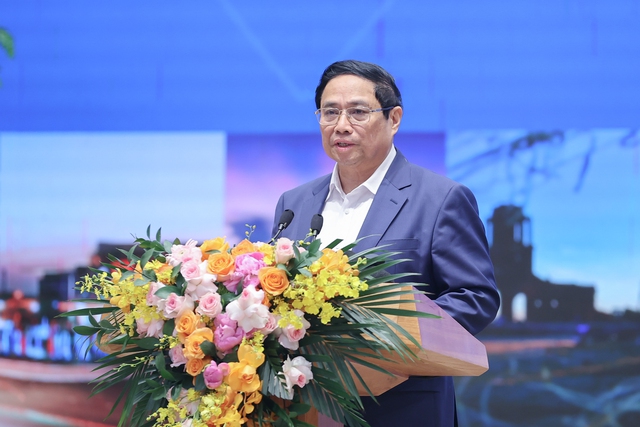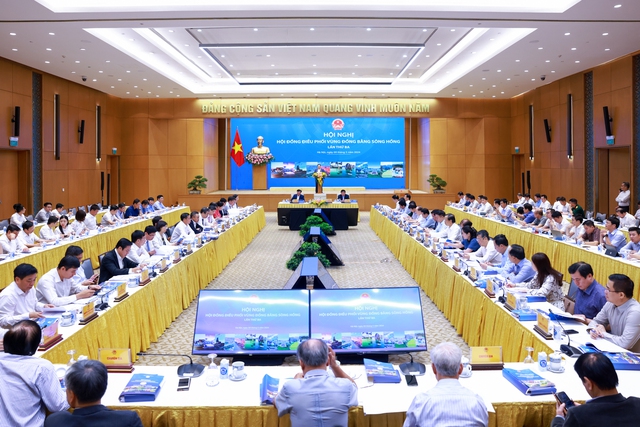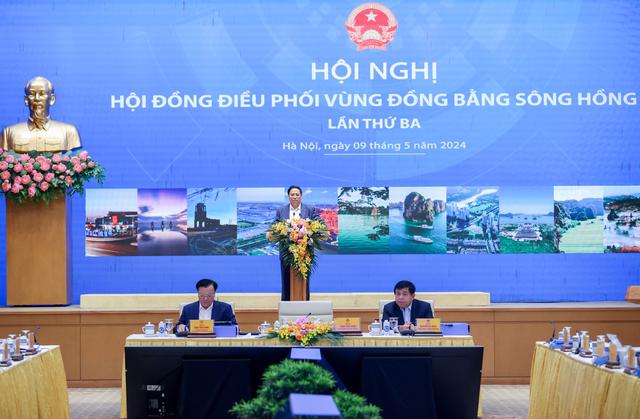Prime Minister Pham Minh Chinh on May 9 outlined an ambitious roadmap for the Red River Delta region's development, underscoring the area's pivotal role in Vietnam's socio-economic progress.
Addressing the 3rd Conference of the Red River Delta Coordination Council, PM Chinh hailed Resolution 30 of the Politburo, which has been diligently implemented and yielded tangible results, fostering newfound confidence, motivation, and a spirit of innovation.
The meticulously crafted regional plan, spanning the period from 2021 to 2030 with a vision extending to 2050, has received high praise for its scientific and thorough approach.
It aims to harness the region's distinct potentials, seize outstanding opportunities, and leverage its competitive advantages while addressing shortcomings and limitations.
By providing a blueprint for viewpoints, visions, and key breakthrough goals, the plan seeks to unlock a new development paradigm and create fresh value for the region and the nation as a whole.
High-ranking officials gathered for a conference focused on the Mekong Delta region. Attendees included Secretary of the Hanoi Party Committee Dinh Tien Dung and Minister of Planning and Investment Nguyen Chi Dung. Leaders from 11 provinces and cities within the delta were also present.
The conference agenda included discussions on the implementation of the regional plan. Progress on Resolution 30 and regional policy mechanisms were also reviewed. Additionally, the Council's coordination plan for 2024 and the status of key projects were examined.
Measured Progress and Persistent Challenges
Despite the region's progress, with a Gross Regional Domestic Product (GRDP) growth rate of 6.28% in 2023, outpacing the national GDP growth of 5.05%, and accounting for 30.4% of the country's GDP, significant challenges persist.
Prime Minister Chinh acknowledged shortcomings such as limited land funds, inadequate breakthrough mechanisms, and a shortage of high-quality human resources in the industrial sector, labeling them as "three shortages."
The region faces several significant limitations. Connectivity remains a major issue, with inadequate transportation infrastructure, gaps in production chains and industry clusters, and weak connections between domestic and foreign businesses.
Water and energy security are pressing concerns. The business sector struggles with limitations in scale, management capacity, and competitiveness.
There is a lack of investment in science and technology, limited startup support, and inadequate innovation. Land management, environmental protection, and climate change mitigation pose additional challenges.
The Prime Minister also highlighted socio-cultural development lagging behind needs, underutilization of the region's unique cultural values, and the persisting difficulties faced by a portion of the population. Political security, social order, and safety in some areas also remain complex factors.
A Visionary Blueprint for Sustainable Transformation
To address these challenges and unlock the region's full potential, Prime Minister Chinh unveiled a visionary blueprint centered around 12 "keywords" (six two-word combinations in Vietnamese): Tradition, Connectivity, Breakthrough, Inclusiveness, Comprehensiveness, Sustainability.
Emphasizing people as the focal point, driving force, and beneficiaries of development, he underscored the importance of science, technology, innovation, entrepreneurship, and strategic breakthroughs.
The plan calls for developing new drivers such as digital transformation, green transformation, circular economy, sharing economy, and knowledge economy, while fostering regional connectivity.
It also aims to tackle pressing issues like population aging, cultural and human resource utilization, and environmental protection.
PM Chinh urged effective implementation without formality, emphasizing transparency, efficiency, and continuous learning.
He advocated mobilizing all resources, particularly through public-private partnerships for strategic infrastructure development, and prioritizing production, job creation, and livelihood improvements.
"Beautiful and advantageous lands and locations must be prioritized for production and business, thereby creating jobs and livelihoods for people," he emphasized.
Prioritizing Key Projects and Attracting Strategic Investors
Among the region's priorities are restructuring economic sectors, innovating growth models towards modernity, and prioritizing investment in dynamic, key projects with substantial spillover effects and international connectivity.
The Prime Minister highlighted the importance of the Hai Phong-Thai Binh-Nam Dinh-Ninh Binh expressway project in creating new momentum, new development space, and connecting the region's heritage areas.
Human resource development, talent attraction, innovation, science and technology application, administrative reform, and investment promotion are also high on the agenda.
The plan calls for attracting strategic investors, particularly in technology sectors like semiconductors, and promoting Public-Private Partnerships (PPPs) for regional and inter-regional transportation infrastructure projects.

Strengthening urban chains, supply chains, logistics, and high-quality services through enhanced linkages is also a focal point. Chinh emphasized the need to "promote linkages between urban chains, supply chains, logistics, and high-quality services."
Coordinated Efforts and Policy Support
To ensure the plan's success, Prime Minister Chinh emphasized the need for coordinated efforts among ministries, central agencies, and local authorities.
He urged effective implementation of specific mechanisms and policies outlined in Resolution No. 106/2023/QH15 of the National Assembly and other approved policies.
The Prime Minister also called for researching and proposing specific institutions, mechanisms, and policies tailored to the Red River Delta region's development and regional integration.
Regular review, adjustment, and experience-sharing processes are essential to ensure the plan's adaptability to evolving circumstances.
Chinh requested ministries and central branches to coordinate with the Ministry of Planning and Investment in organizing supervision and inspection of regional planning implementation.
He also urged them to promptly remove difficulties for the region and provinces and cities in the region to promote synergy in planning implementation.
Impressive Strides and Continued Commitment
The region's achievements thus far are noteworthy, with state budget revenue in 2023 accounting for 38.6% of the country's total, the highest among the six economic regions. From January to May 7, 2024, the region contributed 41.6% of the country's total revenue.
FDI attraction in 2023 reached nearly VND 440.1 billion (USD 17.4 billion), ranking first in the country, with five out of the 11 localities consistently among the top 10 localities for total FDI capital.
The Prime Minister acknowledged and praised the efforts of ministries, branches, agencies, Party Committees, authorities, and people of localities in the region, highlighting their contribution to the country's overall achievements.
However, he stressed the need for continued commitment, urging cadres and party members to uphold their sense of responsibility, dedicate time and effort to common work, and act decisively with passion and enthusiasm for the nation's and people's benefit.
A Clarion Call for Unity and Collaboration
In his concluding remarks, Prime Minister Chinh underscored the importance of unity, agreement, and mutual support among localities within the region.
He urged stakeholders to work together to address regional, inter-provincial, and city-level challenges, fostering a spirit of collaboration and synergy.
The Ministry of Planning and Investment was tasked with absorbing valid inputs from the conference, seeking opinions from relevant ministries, agencies, and localities, and reporting to competent authorities on region-specific mechanisms and policies.
A Momentous Opportunity for Transformation
As the Red River Delta region embarks on this ambitious transformation journey, Prime Minister Chinh's vision presents a momentous opportunity to harness the region's rich heritage, foster connectivity, and embrace breakthrough innovations.
By prioritizing inclusiveness, comprehensiveness, and sustainability, the plan seeks to unlock the region's full socio-economic potential, positioning it as a driving force for Vietnam's continued growth and development.
With coordinated efforts, policy support, and an unwavering commitment to unity and collaboration, the Red River Delta may well emerge as a shining example of sustainable regional development, serving as a model for other regions to emulate.

Prime Minister Chinh's call for "telling the truth, doing the truth, and being truly effective" resonates as a guiding principle, urging stakeholders to shed formalities and perfectionism in favor of pragmatic action, continuous learning, and adaptability.
By fostering public understanding and engagement through initiatives like planning exhibition palaces, the Prime Minister aims to empower people as active participants, beneficiaries, and overseers of the transformation process.
Overcoming Past Shortcomings, Embracing a Sustainable Future
While acknowledging the region's past limitations in areas such as connectivity, water and energy security, business competitiveness, and environmental protection, PM Chinh's vision charts a bold course towards overcoming these challenges.
The emphasis on strategic breakthroughs, innovation, and the adoption of cutting-edge technologies like digital transformation and circular economy principles reflects a commitment to leapfrogging traditional development models.
Moreover, the plan's focus on addressing demographic challenges like population aging and promoting cultural preservation signals a holistic approach to development, one that balances economic imperatives with social and environmental considerations.
By recognizing the importance of human resources, particularly in high-tech sectors such as semiconductors, the government aims to cultivate a skilled workforce capable of driving the region's transition towards a knowledge-based economy.
Leveraging Regional Synergies and Global Connectivity
A key pillar of the Prime Minister's strategy is the promotion of regional integration and global connectivity.
The planned investment in infrastructure projects, such as the Hai Phong-Thai Binh-Nam Dinh-Ninh Binh expressway, is expected to unlock new economic corridors and catalyze the exchange of goods, services, and ideas within the region and beyond.
By strengthening linkages between urban centers, supply chains, logistics networks, and high-value services, the plan seeks to create a seamless economic ecosystem that can compete on a global scale.
This emphasis on interconnectivity aligns with Vietnam's broader efforts to deepen its integration into regional and international trade networks, positioning the Red River Delta as a strategic gateway to the world.
Balancing Growth and Sustainability
While economic growth remains a priority, the Prime Minister's vision underscores the imperative of sustainable development.
The call to "not sacrifice social security or the environment in exchange for simple growth" reflects a recognition of the long-term costs of unchecked exploitation of natural resources and environmental degradation.
By embracing green transformation, circular economy principles, and robust environmental safeguards, the plan aims to decouple economic progress from its environmental impact.
This approach not only supports Vietnam's commitment to addressing climate change but also ensures the long-term viability of the region's development trajectory.
A Collaborative Endeavor
Underpinning the Prime Minister's vision is a recognition that transforming the Red River Delta is a collaborative endeavor, requiring the collective efforts of central and local authorities, private sector actors, and the broader public.
The emphasis on public-private partnerships, particularly in infrastructure development, signals a willingness to leverage private sector resources and expertise to accelerate progress.
Moreover, the Prime Minister's call for unity, agreement, and mutual support among localities within the region underscores the importance of transcending parochial interests in pursuit of shared prosperity.
By fostering a spirit of cooperation and synergy, the plan seeks to harness the combined strengths of the region's diverse provinces and cities.
A Test of Determination and Resilience
As the Red River Delta region embarks on this ambitious transformation journey, Prime Minister Pham Minh Chinh's vision represents a test of Vietnam's determination and resilience.
Overcoming the region's entrenched challenges and realizing the full potential of the plan will require sustained commitment, adaptability, and a willingness to embrace change at all levels of society.
Yet, as Prime Minister Chinh himself acknowledged, the progress made thus far – from the successful implementation of Resolution 30 to the measurable socio-economic gains – serves as a testament to Vietnam's ability to translate vision into action.
With its rich heritage, entrepreneurial spirit, and unwavering commitment to progress, the Red River Delta may well emerge as a beacon of sustainable development, inspiring other regions to embark on their own transformative journeys.









 Google translate
Google translate